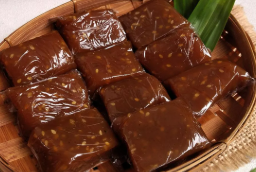ARTS AND CULTURE INFORMATION GATEWAY
Immerse yourself in the colorful world of art and culture! From traditional heritage to contemporary works, discover uniqueness that reflects the nation's identity and identity
DODOL
Picture
1
Video
No record
Today's Visitor
82
Number of Visitors
885
Introduction and history
Dodol is believed to have originated from Indonesia, particularly from the regions of Java and Sunda. Initially, it was a highly popular treat among communities in Southeast Asia, including countries like Malaysia, Brunei, the Philippines, and Singapore.
Dodol is a type of confection made through hours of cooking, using ingredients commonly found in tropical areas, such as coconut milk and palm sugar. This delicacy symbolizes prosperity and abundance due to its lengthy preparation process and the considerable effort required. For this reason, dodol is often a special dish served during grand occasions and important celebrations in local communities.
Dodol became known in Malaysia through cultural and trade exchanges between Malaysia and Indonesia, particularly via the Strait of Malacca, which served as a major trade route in ancient times. Traders brought not only goods but also culinary traditions, including dodol.
Dodol continued to develop among the Malay community in Malaysia, especially in states like Pahang, Selangor, Johor, and Perak. It has become a highly popular traditional treat and is often prepared during Hari Raya celebrations, weddings, and communal feasts (kenduri).
The Role of Dodol in Celebrations
● Hari Raya: Like in other states, Dodol is a must-have dish during Hari Raya celebrations. It is prepared in large quantities to be shared with family, relatives, and guests.
● Weddings: Dodol is also a popular treat at weddings. It is prepared as a symbol of abundance and prosperity, as well as to celebrate this significant event in the lives of the bride and groom.
● Cultural and Traditional Events: In addition to celebrations and weddings, Dodol is often served at communal feasts (kenduri) and cultural events, as part of the traditions and customs of the community.
-
The ingredients for making dodol are simple, but specific techniques are required to achieve the chewy texture and perfect sweetness. Below are the main ingredients used in traditional dodol preparation:
1. Coconut Milk
o Coconut milk is the main ingredient in dodol, providing richness and a smooth texture to the confection. It is obtained by squeezing grated coconut to extract its thick liquid.
2. Glutinous Rice Flour
o Glutinous rice flour gives dodol its chewy texture. It is made from glutinous rice (ketan rice), which is an essential ingredient in traditional Malaysian cuisine.
3. Palm Sugar (Gula Melaka)
o Palm sugar gives dodol its natural sweetness and rich brown color. It is an irreplaceable ingredient in traditional dodol, as it provides the distinctive flavor and strong aroma.
4. Granulated Sugar
o Granulated sugar is used alongside palm sugar to add stronger sweetness to the dodol.
5. Water
o Water is used to dissolve other ingredients and aids in the cooking process of dodol.
6. Salt
o Salt is used to balance the sweetness and provide a slight savory taste for a refreshing contrast.
7. Banana Leaves
o Banana leaves are used to wrap the cooked dodol. Wrapping it in banana leaves not only imparts a unique aroma to the dodol but also helps retain its moisture and gives it a neat presentation.
In Conclusion, the ingredients for making dodol are readily available in Malaysia and other Southeast Asian countries. The combination of coconut milk, glutinous rice flour, and palm sugar creates a chewy, sweet confection with a rich texture. The lengthy cooking process, which requires patience and dedication, also makes dodol a symbolic and meaningful dish for major celebrations and special occasions.
The preparation of dodol requires a unique and time-consuming cooking technique. The cooking process involves mixing all the ingredients in a large wok and cooking them over low heat for several hours while continuously stirring. This process ensures that the dodol achieves its chewy and soft texture and prevents it from burning or sticking.
-
Reference Source
i. Bahan Bacaan
Jamilah, L. (2013). Traditional Malay Desserts: From History to Modern Cuisine. Kuala Lumpur: Pustaka Nasional.
Omar, S. (2016). Kue Tradisional Malaysia: Resep dan Sejarah. Kuala Lumpur: Dewan Bahasa dan Pustaka.
Zulkipli, M. (2010). Warisan Makanan Melayu. Selangor: Utusan Publications.
Location
State JKKN Contact Information
Nur Al-Farani binti Rosli
Cultural Officer
Jabatan Kebudayaan dan Kesenian Negara, Melaka
Kompleks JKKN Melaka
Hang Tuah Jaya, Lebuh Ayer Keroh,
75450 MELAKA
06 - 763 6308
Use the form below to contact the Informant/Figure/Editor/Researcher directly. We will respond to your inquiry as soon as possible!








